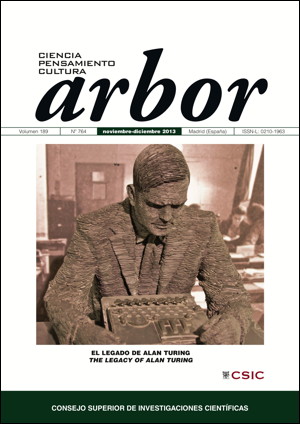Suicide in blue with black stain. Short history of a gunshot in the paintings of Pablo Picasso
DOI:
https://doi.org/10.3989/arbor.2013.764n6010Keywords:
Picasso, Casagemas, Gargallo, suicide, grief, melancholy, blue periodAbstract
Paris 1901: unrequited love drove Carles Casagemas, a close friend of Pablo Picasso’s youth, to commit suicide by shooting himself in the head. This tragic event was a major blow to Picasso, causing him to dwell upon the subject of death and express his “mourning” through his paintings. The “bullet hole” in his friend’s temple symbolically displaced several areas of the young Picasso’s life and became a “deep vacuum” and “melancholy”, permeating various areas in Picasso’s paintings, and marking the start of his famous blue period.
Downloads
References
Bataille, G. (1985). El erotismo. Barcelona: Tusquets editores.
Bataille, G. (2000). La literatura y el mal. Buenos Aires: Ed. El Aleph.
Battistini, M. (2000). Picasso. Barcelona: ed. Electa.
Bujean, D. (2005). Van Gogh. Barcelona: ed. Tandem Verlag GmbH.
Brassaï, G. (2002). Conversaciones con Picasso. México D.F.: ed. Fondo de Cultura Económica.
Cabanne, P. (1982). El siglo de Picasso. Vol. 1, 1881-1937 El nacimiento del cubismo. Madrid: Ministerio de Cultura, D. L.
Cattaneo Rodríguez, G. (2011). “Lo ominoso y el artefacto de la mirada”. Revista Affectio Societatis, Vol. 8, Nº 15, pp. 1-18, diciembre, art. # 16, Medellín, Departamento de Psicoanálisis, Universidad de Antioquia.
Cirici i Pellicer, A. (1981). Picasso. Su vida y su obra. Madrid: N. Editorial.
Cirlot, L. (2007). Primeras vanguardias artísticas: textos y documentos. La Plata: ed. Terramar.
De la Puente, J. (1991). La pintura: de Goya a las últimas tendencias. Barcelona: Carroggio de Ediciones S.A., Tomo 6 de la Historia del Arte.
Eliade, M. (1981) Lo sagrado y lo profano. Madrid: Guadarrama/Punto Omega.
Fermigier, A. (1969). Picasso. Le Livre de Poche. Série Art. Librairie Génerale Française, París, Francia.
Foucault, M. (1977). Historia de la sexualidad. 1- Voluntad de saber. México D.F.: Siglo XXI editores.
Freud, S. (2000). “Lo ominoso”. En Freud, S., (Trabajo original publicado en 1919), Obras completas, Vol. XVII, p. 217-251. Buenos Aires: Argentina Amorrortu ediciones.
Gilot, F. (1965). Vivre avec Picasso. París: Calmann-Lévy.
Golding, J. (1994). Visiones de la modernidad. Berkeley: University of California Press.
Gurmendez, C. (1986). Tratado de las pasiones. México D.F.: Fondo de cultura económica.
Kahnweiler, D. H. (1955). “Entretiens avec Picasso au sujet des Femmes d’Alger”, Aujourd’hui Magazine. Extraído de Edición
de Bernadac, M. L. y Michael, A. (1998), Picasso. Propos sur l’art. París: Gallimard.
Kristeva, J. (2006). Poderes de la perversión, ensayo sobre Louis Ferdinand Celine. Madrid: Siglo XXI editores.
Leader, D. (2011). La moda negra. Duelo, melancolía y depresión. Madrid: Editorial Sexto Piso España, S.L.
Leal, B.; Piot, C.; Bernadac, M. L. (2000). Picasso total. Barcelona: ed. Polígrafa.
Lipovetsky, G. (1994). El crepúsculo del deber. Barcelona: Editorial Anagrama.
Mailer, N. (1997). Picasso retrato del artista joven. Madrid: ed. Santillana. S.A. (Alfaguara).
Malraux, A. (1974). La tête d’obsidienne. París: Gallimard.
Palau i Fabre, J. (1980). Picasso vivent. Barcelona: ed. Polígrafa.
Podoksik, A. (1996). Pablo Picasso: El Ojo Creativo (Desde 1881-1914). Trans. Vladimir Posner Bournemouth. Inglaterra. Parkstone: Aurora Publishers.
Warnke, C. P. (2002). Picasso. Slovenia: Taschen GmbH.
Winnicott, D. (1974). “El temor al derrumbe”. Revista de APDEBA, IV, 2, (1982, artículo póstumo), pp. 111-121.
Zervos, C. (1935). “Conversation avec Picasso”. París: Cahiers d’art, pp. 7-10.
Published
How to Cite
Issue
Section
License
Copyright (c) 2013 Consejo Superior de Investigaciones Científicas (CSIC)

This work is licensed under a Creative Commons Attribution 4.0 International License.
© CSIC. Manuscripts published in both the printed and online versions of this Journal are the property of Consejo Superior de Investigaciones Científicas, and quoting this source is a requirement for any partial or full reproduction.
All contents of this electronic edition, except where otherwise noted, are distributed under a “Creative Commons Attribution 4.0 International” (CC BY 4.0) License. You may read the basic information and the legal text of the license. The indication of the CC BY 4.0 License must be expressly stated in this way when necessary.
Self-archiving in repositories, personal webpages or similar, of any version other than the published by the Editor, is not allowed.














